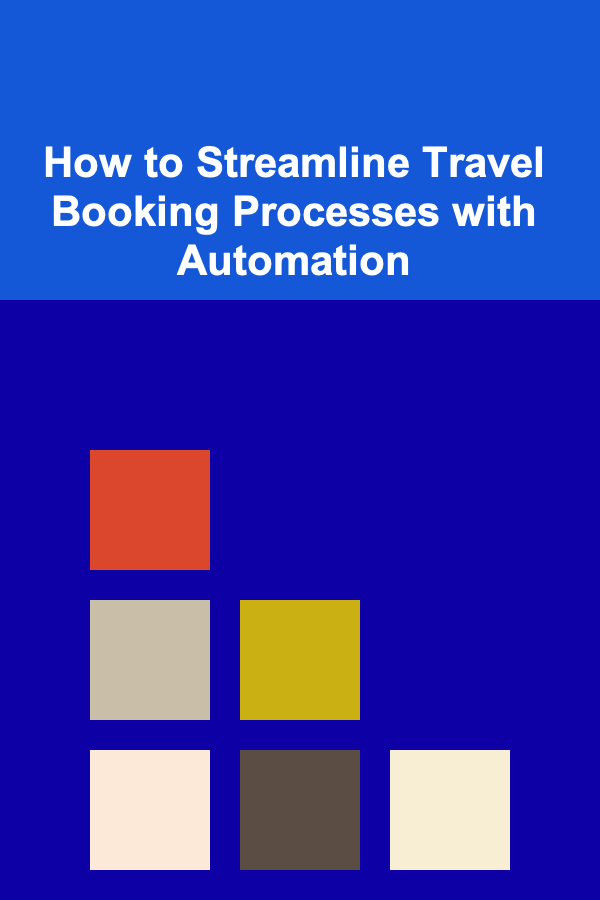
How to Streamline Travel Booking Processes with Automation
ebook include PDF & Audio bundle (Micro Guide)
$12.99$11.99
Limited Time Offer! Order within the next:

In the fast-paced world of modern travel, efficiency and speed are paramount. Travel booking processes, whether for individuals or businesses, have evolved over the years. With the advent of automation, travel companies and consumers alike are reaping the benefits of a streamlined process, making travel planning quicker, easier, and more convenient. This article explores how automation can be used to streamline travel booking processes, highlighting its importance, benefits, tools, and real-world examples.
The Importance of Streamlining Travel Booking
Travel booking involves multiple steps, including searching for flights, hotels, car rentals, tours, and more. The process can be overwhelming, especially for those unfamiliar with the options available. Whether it's a corporate travel manager trying to book travel for employees or an individual traveler planning a vacation, the process can be time-consuming.
Automation is the key to eliminating many of the manual tasks that slow down the process. By automating various elements of travel booking, such as customer interactions, reservations, and follow-ups, travel companies can increase efficiency and reduce human error, leading to a more satisfactory experience for travelers.
Reducing Time and Effort
One of the most significant benefits of automation is the reduction in the time and effort required to complete a booking. Travelers no longer have to manually search for flights, hotels, or rental cars. Instead, automation tools can find the best deals based on pre-set criteria, including budget, dates, location, and other preferences.
For businesses, automation reduces the amount of time spent on administrative tasks such as data entry and invoice processing. Employees can book travel in just a few clicks, and all the necessary documentation, such as tickets and itineraries, are automatically generated.
Minimizing Errors
Manual booking processes are prone to human error. Whether it's entering incorrect information or overlooking important details, errors can lead to confusion, delays, or additional costs. Automation significantly reduces the risk of mistakes by ensuring that data is input correctly and consistently. Automated systems can also cross-check booking details, confirming that everything aligns with the traveler's preferences.
Personalizing the Experience
Automation doesn't just save time; it can also create a more personalized travel experience. With AI and machine learning, automation tools can learn from past bookings and customer preferences to offer tailored recommendations. This leads to a more customized experience, helping travelers find the best options based on their unique needs and desires.
Key Areas of Travel Booking Automation
Automation can streamline various aspects of the travel booking process. Let's take a closer look at the main areas where automation can make a significant impact:
1. Search and Comparison
Travel search engines, powered by automation, have become essential for finding the best flight, hotel, and car rental options. These platforms aggregate data from hundreds or even thousands of sources, providing travelers with a comprehensive overview of available options in seconds.
Automation takes the hassle out of manual searching, comparing prices, and checking availability. It also ensures that travelers are presented with the most up-to-date and relevant options based on their preferences, including budget, travel dates, and location.
Popular platforms such as Google Flights, Skyscanner, and Kayak use automation to pull data from airlines, hotels, and rental car companies in real-time. By automatically comparing different providers and their prices, these platforms help travelers make more informed decisions faster.
2. Reservations and Payments
Once a traveler has found their preferred flight, hotel, or rental car, the next step is to make a reservation and process the payment. This is where automation truly shines.
Automated booking systems allow travelers to reserve their accommodations or flights in a few clicks. Payment information can be securely stored, reducing the need for manual input on each booking. Automated systems can also handle special requests, such as meal preferences, seating preferences, and room types, making the booking process smoother.
For businesses, automation tools can handle group bookings, where multiple people need to travel at the same time. These systems simplify the process by allowing users to enter group travel details once and generate all necessary bookings simultaneously.
3. Itinerary Creation and Updates
After a booking is made, travelers need to have access to their itinerary. Manual tracking of flights, hotel check-ins, and car rentals can be tedious and prone to error.
Automation tools can create an itinerary instantly, consolidating all relevant details into one easy-to-read document. Travelers can receive real-time updates about any changes to their flights, hotel bookings, or car rentals. This helps eliminate confusion and ensures that travelers have accurate and up-to-date information at their fingertips.
For businesses, automated itinerary management systems provide employees with a clear overview of their travel plans, including flight details, accommodations, meetings, and transportation.
4. Customer Service and Support
Customer service is a critical component of the travel experience. With automation, companies can streamline customer interactions, providing faster responses and resolutions.
Chatbots and AI-powered customer service tools can answer questions, resolve booking issues, and provide assistance 24/7. These tools use natural language processing (NLP) to understand customer queries and provide accurate responses, without the need for human intervention. In case the issue is more complex, the chatbot can escalate the matter to a human agent.
Automating customer service processes can significantly reduce response times, improve customer satisfaction, and reduce the burden on human agents.
5. Post-Booking Services
Automation continues to play a vital role after a booking is complete. Post-booking tasks such as sending confirmations, reminders, and feedback requests can be automated, ensuring that customers stay informed and engaged throughout their travel journey.
For example, automated systems can send travelers a reminder a few days before their flight, providing them with essential details such as check-in instructions and baggage policies. Similarly, after the trip, automated emails can request feedback on the traveler's experience, helping companies improve their services.
Tools and Technologies for Travel Booking Automation
To streamline travel booking processes, businesses and travelers can use various automation tools and technologies. Below are some of the most effective tools that help automate different parts of the travel process:
1. Global Distribution Systems (GDS)
Global Distribution Systems, such as Sabre, Amadeus, and Travelport, are used by travel agencies, airlines, and hotels to distribute and manage travel services. These systems are automated platforms that connect travel service providers (airlines, hotels, rental car companies) with travel agents, allowing them to search for, book, and manage travel arrangements.
2. Artificial Intelligence (AI) and Machine Learning
AI and machine learning are revolutionizing the travel booking industry. These technologies are used to personalize recommendations, predict traveler preferences, and offer customized itineraries. AI-powered chatbots and virtual assistants are also increasingly being used to handle customer inquiries and streamline the booking process.
3. Online Travel Agencies (OTAs)
Online travel agencies like Expedia, Booking.com, and Trip.com have automated platforms that allow users to book flights, hotels, car rentals, and even activities all in one place. These platforms aggregate travel information and offer automated booking options, allowing for a seamless experience.
4. Travel Management Software
For businesses, travel management software (TMS) helps streamline the booking process by automating approvals, itinerary creation, and expense management. These tools integrate with other systems to ensure that all aspects of corporate travel are efficiently managed.
5. Payment Gateway Solutions
Automating payments is crucial for a smooth travel booking process. Payment gateways such as PayPal, Stripe, and Square allow users to make secure payments for travel bookings, eliminating the need for manual payment processing.
Real-World Examples of Automated Travel Booking Systems
1. Kayak
Kayak is a popular travel search engine that uses automation to help travelers find the best flight, hotel, and car rental options. The platform's automation algorithms compare prices in real-time from a wide range of sources, helping users find the most affordable options based on their preferences. Kayak also offers automated email alerts to notify users of price drops, ensuring they never miss a great deal.
2. TripActions
TripActions is a travel management platform used by businesses to automate corporate travel booking. The platform integrates with various travel providers, enabling employees to book flights, hotels, and rental cars directly through the system. TripActions automates approval workflows, ensuring compliance with company policies and helping businesses save money on travel expenses.
3. Google Flights
Google Flights is another example of an automated travel booking platform. Using automation, it scans multiple airlines and travel websites to find the best flight deals based on user preferences. Google Flights also sends real-time alerts when flight prices change, helping travelers make timely decisions.
Conclusion
The travel industry is evolving rapidly, and automation is playing a central role in transforming the travel booking process. By streamlining the search, booking, and post-booking stages, automation offers significant benefits in terms of efficiency, cost-saving, and customer satisfaction.
Whether it's personal travel or business travel, the integration of automated tools can save time, reduce errors, and provide a more personalized experience. As technology continues to advance, the future of travel booking looks brighter, with even more opportunities for automation to simplify the process.
By embracing automation, travel companies and consumers can enjoy a more seamless, efficient, and cost-effective travel experience, making the complex process of booking travel simpler and faster than ever before.
This marks the end of the article. Let me know if you'd like any further changes or additions!
Reading More From Our Other Websites
- [Trail Running Tip 101] Hit the Trail: How Trail Running Can Kickstart a New Chapter in Your Life
- [Home Pet Care 101] How to Keep Your Pet's Skin Healthy and Free of Irritations
- [Soap Making Tip 101] The Beginner's Guide to DIY Lye-Free Soap: Tools, Ingredients, and Tips
- [Personal Financial Planning 101] How to Get Out of Credit Card Debt and Stay Debt-Free
- [Simple Life Tip 101] Best Indoor Gardening Tips for a Simple Life in Small Urban Apartments
- [Survival Kit 101] How to Build a Compact Survival Kit for Urban Cyclists Facing Traffic Accidents
- [Organization Tip 101] How to Utilize Digital To-Do Lists for Increased Productivity
- [Home Budget Decorating 101] How to Create a Stylish Gallery Wall Without Breaking the Bank
- [Personal Investment 101] How to Invest in a Vanguard Personal Pension for Long-Term Growth
- [Home Rental Property 101] How to Use Rental Agreements to Protect Your Property

How to Clean Your Home Efficiently on a Tight Schedule
Read More
How to Monetize Your Makeup Skills Through Part-Time Work and Side Hustles
Read More
How to Organize a Smooth and Memorable Birthday Party at Home
Read More
How to Stage a Home with Vintage or Antique Furniture
Read More
How to Design Sustainable Smart Cities
Read More
Kayaking Through Wild Rivers: A Comprehensive Guide
Read MoreOther Products

How to Clean Your Home Efficiently on a Tight Schedule
Read More
How to Monetize Your Makeup Skills Through Part-Time Work and Side Hustles
Read More
How to Organize a Smooth and Memorable Birthday Party at Home
Read More
How to Stage a Home with Vintage or Antique Furniture
Read More
How to Design Sustainable Smart Cities
Read More